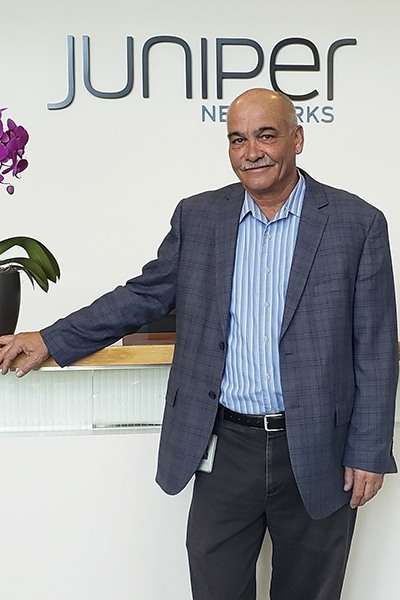|
Getting your Trinity Audio player ready...
|
Brad Minnis has spent time peering through binoculars in an unmarked van and digging for documents in a Chinese dumpster. He’s not the hero of a detective novel or the protagonist in a spy film—he’s a veteran safety and security leader who’s spent decades designing security programs for office buildings, data centers, and corporate research facilities in numerous countries around the world.
Today, Minnis is vice president of environmental health, safety, and security at Juniper Networks, where he’s leveraging his deep experience and expertise to keep employees and data at the leading technology and computer networking company secure.

The VP has been working in Silicon Valley since the early 1980s. He spent 11 years at National Semiconductor, a corporation where he designed and implemented auditing programs for advanced facilities in the United States and across the Asia Pacific Rim. He then went to 3Com, where he helped protect the company against product counterfeiting and gray marketing, or the fraudulent resale of discounted products. As Minnis discovered counterfeit products in the field, he collected evidence—sometimes in dumpsters—and coordinated raids with local and federal agencies.
The threats Minnis encountered present significant challenges. Counterfeiters flood the market with massive amounts of discounted and fake products. Users who purchase those products often have no idea that they are fake until the faulty items fail. In response, Minnis started 3Com’s brand protection group, one of the first units in the country to deal with cross-border transactions.
While the program was a success, 3Com turned its attention to the launch of an innovative tech product known as the PalmPilot and the organization’s networking business plummeted. Minnis was ready to move on and joined Juniper Networks in 2001 on the heels of what was once the most successful initial public offering in the history of the NASDAQ.
Juniper Networks is a manufacturer of high-performance networking equipment like routers, switches, and security products for large networks. Minnis joined the organization to build its health, safety, and security program from the ground up. In doing so, he wanted to introduce something the program at 3Com lacked: prevention. “Going on raids and taking down bad guys never fully solves the problem because it’s usually internal issues that create the opportunities they exploit,” Minnis says. He focused on turning himself into a network architect that would build a new system to protect Juniper.
Over the past 2 decades, he’s built, maintained, and optimized a robust environmental, health, safety, and security framework for all of Juniper’s operations in 47 countries. The program addresses critical issues related to supply chain security, health and safety, and cybersecurity.
Minnis and his team provide the tools, resources, and equipment employees and facilities managers need to stay safe on the job, and the company is using its advanced understanding of technology to find efficiencies. When COVID-19 hit, Juniper enacted a legacy pandemic plan created after the SARS outbreak in 2003. Minnis used Mist Systems, a Juniper company, to manage buildings in a whole new way.
Mist AI connects with Bluetooth devices on employee badges to create a new contact tracing and occupancy management solution. Location array antennae, beacons, and access points deployed through a building send information to a dashboard in real time, which managers access to see where employees enter a building, where they travel, who they interact with, which beacons they are near, and the duration of their visit.
Minnis deployed the system when Juniper needed essential employees on campus at the height of the pandemic. Safety and security personnel receive automated alerts when Mist detects that too many employees have entered a zone or finds other violations to CDC workplace guidelines.
As COVID-19 recedes over time, Juniper Networks is allowing some nonessential workers to reenter its facilities. Minnis expects the company to create a hybrid environment for most employees. “The workplace is changing in the post-pandemic world. We haven’t determined exactly what it will look like, but we know we’ll be here to keep our people and our company safe and effective,” he says.
With people working remotely, Juniper is facing more threats than ever before. Minnis knows individuals and nation states are looking for a way to attack and infiltrate his company’s network. “Companies like ours are a target and there will always be attacks, but we’ll always be prepared,” says Minnis, adding that he continues to monitor the fluctuating threat landscape.
Today, Juniper is a company with billions of dollars in annual revenue that is growing its market share in multiple categories. Industry insiders say an emphasis on cloud-based technologies and artificial intelligence will bring sustained revenue growth. Its leaders are optimistic about the future, and Minnis and his team are in position to keep Juniper protected as it develops and releases new products and innovations.


